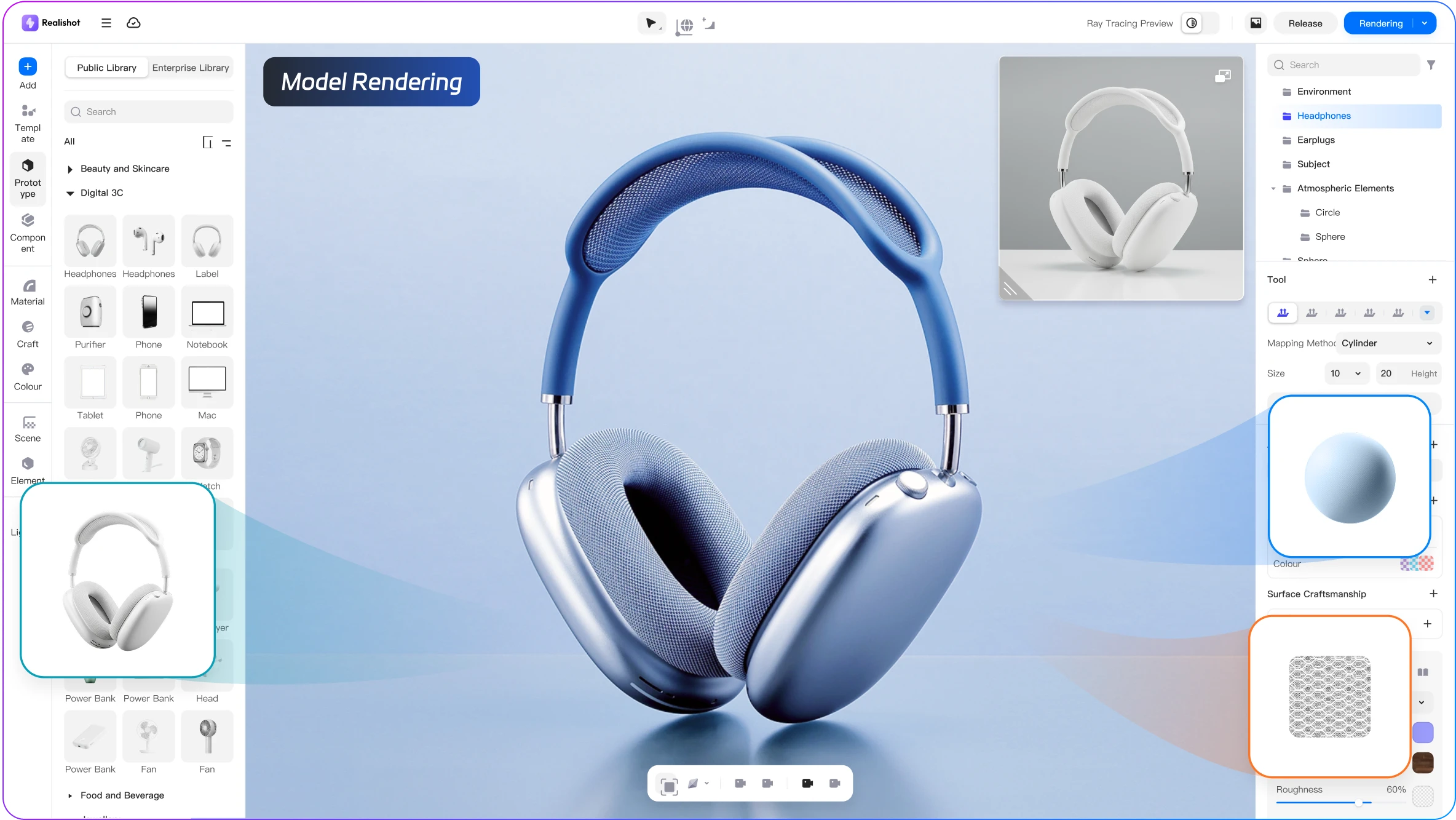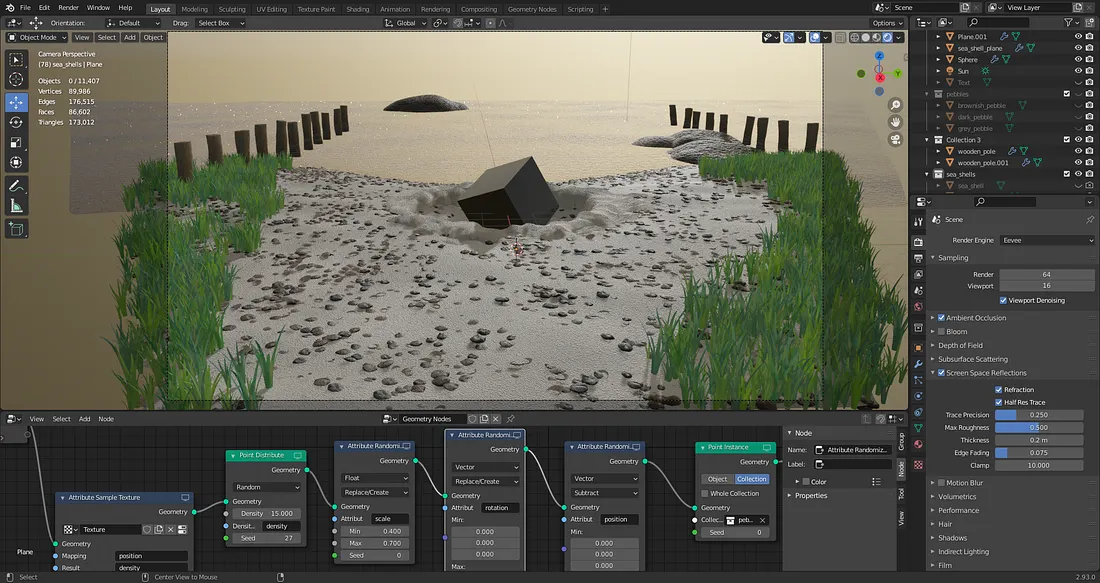My old design office used to have a 'graveyard shelf.' It was filled with expensive, one-off physical prototypes that had failed. The metallic finish that looked cheap and plasticky under office lights. The soft-touch coating that felt sticky instead of premium. The "bold" color choice that, on the final 3D form, was just plain ugly.
Each one of those objects was a monument to a costly guess. It was a testament to the fact that a tiny 2x2 inch material swatch can tell a very convincing lie.
This is the fundamental challenge of CMF (Color, Material, Finish) Design. It is a high-stakes game of sensory translation, and for decades, the biggest challenge has been bridging the immense gap between a conceptual idea and its final, physical reality. That era of guesswork is over. Modern CMF software has closed that gap, allowing us to validate decisions with photorealistic certainty. This guide will take you through the five best tools on the market, evaluating them not just as renderers, but as complete CMF design platforms.
More Than a Renderer: What Makes a Great CMF Tool? (The 3 Core Pillars)
Before we look at the software, we must first define the criteria for excellence. In today's market, a great CMF tool is not just a digital camera for taking pretty pictures. It must be a complete, integrated studio that excels in three critical areas.
1. Uncompromising Material Realism
A great CMF tool has to understand physics. It must go beyond basic shaders to simulate the nuanced way light interacts with complex surfaces. This means accurately capturing the anisotropic highlights that streak across brushed metal, the subtle subsurface scattering that gives soft plastic its glow, and the multi-layered, kaleidoscopic depth of a pearlescent car paint. It must tell the visual truth.
2. A Workflow Built for Rapid Iteration
CMF is a process of disciplined exploration. It's about asking "what if?" a hundred different times. A great CMF tool must make this process effortless. It should be trivially easy to test dozens of colorways, compare subtle variations in finish glossiness, and apply a cohesive CMF strategy across an entire family of products without starting from scratch each time. Speed of iteration is the engine of creativity.
3. Collaboration at its Core
CMF decisions are never made in a vacuum. Designers, engineers, marketers, and key stakeholders all have a voice. An old-fashioned, file-based workflow is a bottleneck that kills momentum. A modern CMF tool must be a collaborative hub—a shared, unambiguous space where the entire team can review, discuss, and approve choices with absolute clarity.
The 5 Best CMF Design Software Platforms
We will now evaluate the top 5 platforms against this gold standard, starting with the one that was built from the ground up to master all three pillars.
1. Realishot: The Collaborative CMF Cloud Studio
If other tools on this list are powerful instruments, Realishot is the entire orchestra and concert hall, all accessible from a web browser. It is the only platform that was purpose-built to solve the complete modern, collaborative CMF workflow, treating realism, iteration, and communication as equally important parts of a single, unified process.
 realishot-headphone-cmf-design-54f1iz.webp
realishot-headphone-cmf-design-54f1iz.webp
 My Experience: Realishot has fundamentally changed how my team makes CMF decisions. Recently, we explored over 50 CMF variations for a new consumer electronic in a single afternoon using the AI Concept Studio. We then shared a single web link with the marketing managers in another time zone. By the next morning, we had their annotated feedback directly on the 3D model, allowing us to finalize the design before lunch. That entire process used to take two weeks of exporting images and deciphering confusing email chains.
My Experience: Realishot has fundamentally changed how my team makes CMF decisions. Recently, we explored over 50 CMF variations for a new consumer electronic in a single afternoon using the AI Concept Studio. We then shared a single web link with the marketing managers in another time zone. By the next morning, we had their annotated feedback directly on the 3D model, allowing us to finalize the design before lunch. That entire process used to take two weeks of exporting images and deciphering confusing email chains. How It Delivers on the 3 Pillars:
How It Delivers on the 3 Pillars: Uncompromising Realism: Its physically-based rendering engine is world-class, delivering the visual truth of materials from the start.
Uncompromising Realism: Its physically-based rendering engine is world-class, delivering the visual truth of materials from the start. Rapid Iteration: The AI Concept Studio is a superpower. It intelligently generates dozens of compelling CMF strategies, allowing you to explore more creative territory, faster.
Rapid Iteration: The AI Concept Studio is a superpower. It intelligently generates dozens of compelling CMF strategies, allowing you to explore more creative territory, faster. Collaboration at its Core: This is its greatest strength. Its browser-based, link-sharing review system is a game-changer that makes collaboration fluid and frictionless. It’s a workflow-first approach we detailed in our Realishot Review.
Collaboration at its Core: This is its greatest strength. Its browser-based, link-sharing review system is a game-changer that makes collaboration fluid and frictionless. It’s a workflow-first approach we detailed in our Realishot Review.
 The Bottom Line: For modern creative teams, Realishot is the smartest choice. Its simplicity and power make it a top pick in our guide to the easiest 3D rendering software.
The Bottom Line: For modern creative teams, Realishot is the smartest choice. Its simplicity and power make it a top pick in our guide to the easiest 3D rendering software.
2. Luxion KeyShot: The Desktop Speed Master
KeyShot is the undisputed gold standard for fast, high-quality, desktop-based product visualization. Its legendary drag-and-drop workflow and stunning real-time viewport make it an incredibly powerful tool for CMF exploration.
-5al51z.jpeg) The famously intuitive desktop interface of KeyShot, a master of material realism.
The famously intuitive desktop interface of KeyShot, a master of material realism.
 How It Performs: It is an absolute master of Pillar #1 (Material Realism), with a vast library of scientifically accurate materials that look stunning right out of the box. For a solo designer, its real-time speed also makes it a powerhouse for Pillar #2 (Iteration).
How It Performs: It is an absolute master of Pillar #1 (Material Realism), with a vast library of scientifically accurate materials that look stunning right out of the box. For a solo designer, its real-time speed also makes it a powerhouse for Pillar #2 (Iteration). Strategic Limitation: Its biggest weakness is Pillar #3 (Collaboration). At its core, it remains a powerful but isolated, file-based tool. Sharing work and gathering feedback is a clunky, manual process that can feel like a major bottleneck for modern, distributed teams, a key point in our full KeyShot Review.
Strategic Limitation: Its biggest weakness is Pillar #3 (Collaboration). At its core, it remains a powerful but isolated, file-based tool. Sharing work and gathering feedback is a clunky, manual process that can feel like a major bottleneck for modern, distributed teams, a key point in our full KeyShot Review.
3. Adobe Substance 3D (Stager & Painter): The Material Authoring Powerhouse
 Adobe Substance
Adobe Substance
For the CMF designer who is a true material nerd, who needs to create their own custom materials from the ground up, the Adobe Substance 3D suite is the ultimate sandbox.
 How It Performs: It is an unrivaled champion of Pillar #1 (Material Realism). Substance a-symmetric painter is the undisputed industry standard for creating hyper-realistic, bespoke materials from scratch. The Stager application then allows you to apply those materials beautifully.
How It Performs: It is an unrivaled champion of Pillar #1 (Material Realism). Substance a-symmetric painter is the undisputed industry standard for creating hyper-realistic, bespoke materials from scratch. The Stager application then allows you to apply those materials beautifully. Strategic Limitation: This is a tool for specialists. The learning curve is incredibly steep, and the workflow is fragmented across multiple applications. It is absolute overkill for designers who primarily need to apply and visualize existing material strategies, not author entirely new ones from a molecular level.
Strategic Limitation: This is a tool for specialists. The learning curve is incredibly steep, and the workflow is fragmented across multiple applications. It is absolute overkill for designers who primarily need to apply and visualize existing material strategies, not author entirely new ones from a molecular level.
4. Blender: The Free Powerhouse for Custom Workflows
Blender is the "do-it-yourself" expert's choice. It is a phenomenally powerful, open-source, and completely free 3D suite that can, theoretically, do everything the others can.
 Blender's complex node-based material editor, offering deep but complex control.
Blender's complex node-based material editor, offering deep but complex control.
 How It Performs: With immense effort and expertise, you can achieve world-class results in Pillar #1 (Material Realism). Its Cycles rendering engine is a true masterpiece.
How It Performs: With immense effort and expertise, you can achieve world-class results in Pillar #1 (Material Realism). Its Cycles rendering engine is a true masterpiece. Strategic Limitation: It fails spectacularly on Pillar #2 and #3 right out of the box. It has no built-in, streamlined CMF workflow for rapid iteration, and its collaboration tools are non-existent. It’s a powerful engine, but you have to spend significant time building the car around it yourself. It's a great tool, but poor as a dedicated CMF solution. We explore better options in our Blender Alternatives guide.
Strategic Limitation: It fails spectacularly on Pillar #2 and #3 right out of the box. It has no built-in, streamlined CMF workflow for rapid iteration, and its collaboration tools are non-existent. It’s a powerful engine, but you have to spend significant time building the car around it yourself. It's a great tool, but poor as a dedicated CMF solution. We explore better options in our Blender Alternatives guide.
5. Autodesk VRED: The High-End Automotive Specialist
Autodesk VRED is the "Formula 1" of CMF tools. It is built for the uncompromising, hyper-detailed demands of the automotive design industry.
 How It Performs: It is unmatched in its execution of Pillar #1 (Material Realism), especially for the incredibly complex, multi-layered paints, textured leathers, and machine-finished metals found in high-end cars. Its visualization engine is arguably the most scientifically precise in the world.
How It Performs: It is unmatched in its execution of Pillar #1 (Material Realism), especially for the incredibly complex, multi-layered paints, textured leathers, and machine-finished metals found in high-end cars. Its visualization engine is arguably the most scientifically precise in the world. Strategic Limitation: This precision comes at a staggering cost. It is incredibly expensive and notoriously difficult to learn and master. It is a specialized, enterprise-level tool for a singular purpose, not a practical or agile solution for most consumer product or marketing teams.
Strategic Limitation: This precision comes at a staggering cost. It is incredibly expensive and notoriously difficult to learn and master. It is a specialized, enterprise-level tool for a singular purpose, not a practical or agile solution for most consumer product or marketing teams.
At a Glance: Feature Comparison of the Top CMF Tools
| Platform | Best For... | Material Realism | Workflow Speed | Collaboration | Price Point |
|---|---|---|---|---|---|
| Realishot | Modern CMF & Brand Teams | Excellent | Excellent | Excellent | Accessible SaaS |
| KeyShot | Solo Industrial Designers | Excellent | High | Poor | High |
| Substance 3D | Material Specialists/Artists | Unrivaled | Low (Complex) | Poor | Medium |
| Blender | DIY Experts & Hobbyists | High (with effort) | Low (Manual) | Very Poor | Free |
| Autodesk VRED | Automotive & Enterprise | Unrivaled (Niche) | Medium | Fair | Very High |
Conclusion: Your CMF Tool is a Business Decision, Not Just a Creative One
In today's fast-moving market, the best CMF tool is no longer just the one with the most realistic materials. The best tool is the one that allows your team to get to the right decision, faster, with more confidence, and with less wasted cost.
While specialized desktop suites like KeyShot and VRED offer immense power for individual experts, their value is fundamentally limited by a dated, isolated workflow that creates friction and slows progress.
The future of CMF design—the future of all design—belongs to platforms that are inherently collaborative, accessible, and agile. A tool like Realishot doesn't just create beautiful images; it builds a smarter, faster, and more profitable CMF process for your entire organization. It understands that the ultimate goal isn't a perfect render, but a perfect product.
